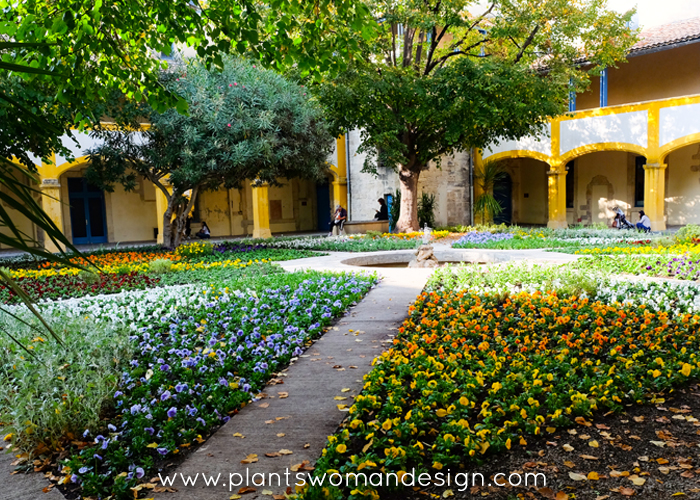
Traveling Plantswoman: Arles, France 2017


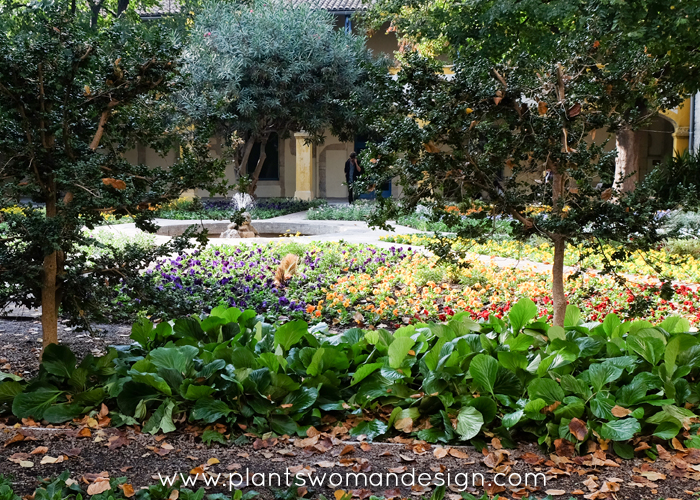





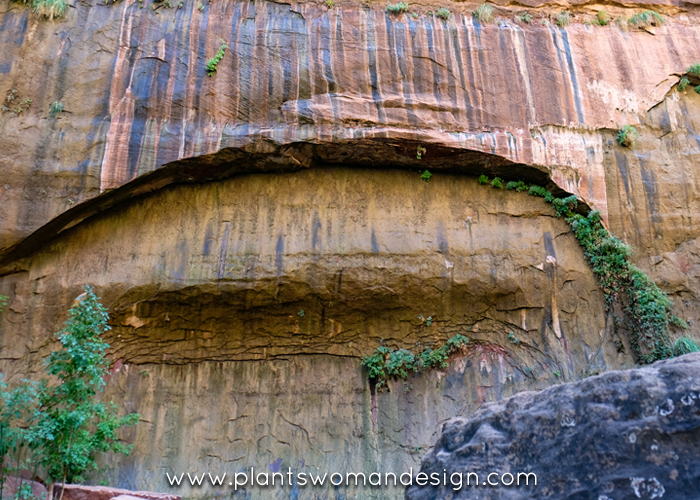
A long awaited vacation always provides opportunity for exploration of other types of scenery. I’m always look for new types of plants or in this case a new type of gardening.
This week I find myself at Zion National Park which has a diverse
collection of plant communities. I was surprised by the relative
lushness found in Zion Canyon. The riparian area of the Virgin River
supports enormous cottonwood trees and a diverse collection of
herbaceous plants and grasses. Nearby, saturated wetlands make nice
habitat for cattails, willows, aquatic plants, and rushes. Water seeping
out of the Navajo sandstone creates tranquil springs and the unique
“hanging gardens” for which Zion is famous, full of ferns, wildflowers,
and mosses.
Here I found many of the same species of wildflowers that I see in Washington forests. It was so amazing to see maidenhair ferns, columbine, and Indian paintbrush clinging to little crevices in the rocks with seemingly no soil just the nutrients from the water seeping from the rocks. It felt like it was raining but looking up into the clear blue sky it was obvious that the water was falling from the rock hundreds of feet above my head. The water in the Virgin River is a cloudy milky colored blue. Probably from the high mineral content of the water as the erosion of the cliffs continues.
Near the north end of the park on the Taylor Creek Trail I could see ponderosa pines high on the sandstone cliffs clinging to cracks and ledges. These massive trees push their powerful roots into the Navajo Sandstone, adding to the slow process of erosion that is constantly changing the face of Zion. The dusty trail lead through juniper and creosote brush interspersed with tiny wildflowers. Dropping into the river and walking through the water filled slot canyons kept us cool.
One of the most amazing things was to see Datura wrightii, or Devils Trumpet, growing wild. The large white flowers and blue green leaves look like the non-hardy tropical variety I overwinter each year in the green house. This one however is a Utah native that grows in the roadside ditches. The hardiness map says that the St George Area is 8a. It seems hard to believe it can grow here. Maybe a small thorny seed will find its way into my bag for the return trip. Don’t worry I’ll get it outside the park as taking any plant material from a National Park is illegal.
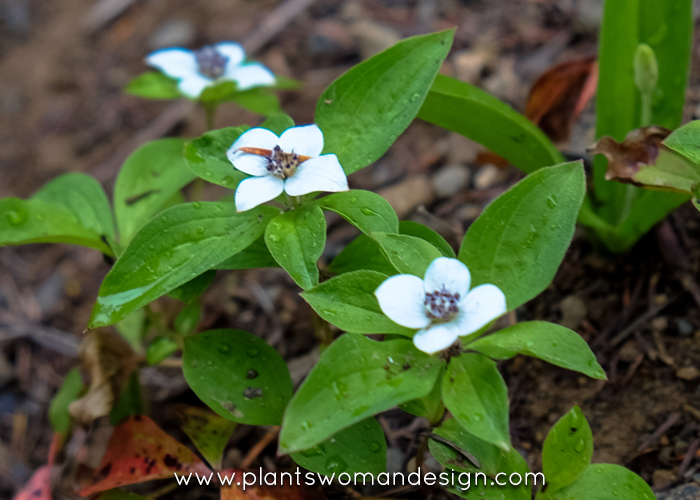
One of the main reasons I left an accounting career to do garden design was so I could be outdoors. At first gardening was just a way to be outdoors and still make a living. Now gardening has turned into a passion, not just a job. However, I still look for ways to get outside. This past weekend it was a trip to the Tubal Cain trail. I like to mix in my love of plants with my love of outdoors. Often I’m left behind while I stop over and over to check out a plant that caught my eye.
I was hoping to see some wildflowers but did think it was a little early to see much. I never expected to see the native rhododendron (Rhododendron macrophyllum) in such amazing beautiful color. The understory of much of the trail was completely covered in blooming Rhododendron. In different phases of bloom and different colors of pink, the blooms went from deep pink purple to light cotton candy pink.
Along the trail on the way up there were brilliant red columbine Aquilegia Formosa tucked into shady places. The scree (gravel washes) had Cornus Canadensis, Saxifraga and Clintona uniflora or queen’s cup growing along the edge of the trail. Frittilaria lancelota was up and solid green. The tip of the flower had been formed but was still small and the same color.
My goal was to get to the alpine meadow at the end of the trail. The long slope was flowering with early spring/summer flowers. Mountain phlox, lupine, campanula, penstemon and Thalictrum were just beginning to bloom showing soft subtle colors this early in the year. As the summer progresses their colors will change to more brilliant shades.
We sat down to eat our lunch on a rock next to the trail, turned around and were surprised to see the large form of Mt Buckthorn in front of us. Clouds were moving around it and the sun was playing with shadows and forms on the snow.
Turning around after 2 ½ hours we came back down the trail still looking for a coral root. I finally spotted this hardy orchid and tried to get a good picture but all of the photos came out poorly. This photo is from the Native Plant Society of Washington.
If you get a chance to take a walk, go now. The Rhododendrons will be blooming for a couple of weeks still and the variety of wildflowers blooming will just keep getting better. The trail is an easy 8 – 10 miles round trip with elevation gain of only 1000 feet over 4 miles. Take your camera, pack your lunch, and have beer in the cooler when you get back. That’s the way to hike.
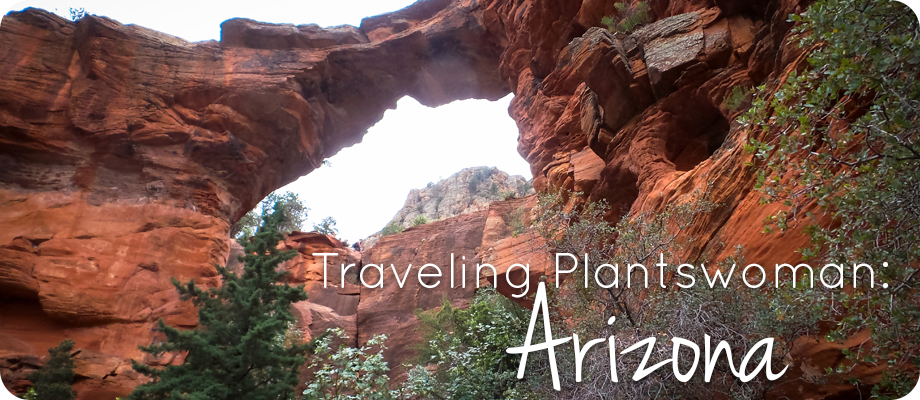
It’s nice to get away from the Pacific Northwest in the spring. Sometimes you can count on a beautiful Memorial Day but usually it will rain and this year was no exception. Lots of rain but not for me as I was in Phoenix visiting family, a great place to visit this time of year. Not hot yet, a mild 70 – 80 degrees, which is not hot even by our standards. Surrounded by friends and family, I usually force them into a visit to a botanical garden or other horticultural activity. This time I was content to go with the general votes as to activity and not force others into seemingly endless views of plants and flowers. We drove to Sedona and went on two great hikes. I was usually at the end of the line of 6 hurrying to catch up after taking pictures.
This May has seen a lot of rain in the Phoenix area as well. The hills surrounding the city are sage green instead of various shades of brown. The first day we hiked to Devil’s Bridge, which is a fascinating upper desert hike. Cactus, Oxanix, Yucca, were blooming as expected but what I did not expect was the amazing variety of wildflowers in the sand and gravel. The trail was dry and dusty but alongside were blooming daisy, pennstemon, grasses, yellow lineanara, a light purple thistle/centura, and MANY things I did not recognize. I stopped again and again taking pictures and will continue to do research on varieties found there. Some of them looked very similar to the New Zealand plants that are very popular in nurseries for our Mediterranean climate. Several trees, including varieties of Pines, and deciduous lovely green leaved trees lined the trail. But one of the standouts for me (hater of Juniper) was the colorful juniper with beautiful multi-colored bark. Looking similar to the Eucalyptus trees we found in Hawaii, I would have never expected to love them. The sage green coniferous foliage was a great contrast to the bark. It felt like I was walking through a botanical garden with a very natural design. The grasses massed together naturally and the bright spots of color stood out against the contrast of rocks and gravel.
Smooth, beautifully worn large pieces of sandstone were crossed and you could see were flash flooding or old streambeds created washes, and collections of rocks along the edges of the trail.
Air was fresh and scented with sages and the juniper. I know I’m writing mostly about the plants but the rock formation of Devil’s Bridge was amazing too.
After spending time in the dry desert of Sedona on one day we decided to visit the river the next. There is a lovely hike along the river, just a short distance away. The two areas could not have been more different. It was cooler, shaded, with an unexpected lushness. The plants were different with subtle color and texture. Ferns! Yes ferns growing under the larger trees.
The trail meanders along the river with 12 crossings with sandstone under foot was easy too walk on. If you happened to slip and fall in the water it just felt great. As we went up river the sides of the valley became steeper and the rock formations towered over us. A cool spot for a picnic lunch then back along the river back to the parking lot. Cool drinks awaited us when we got back to the cars. Such a great hike!
Interested in creating a more natural look and feel in your own garden? Take a look below.

The Plantswoman
Hello and welcome! I'm Susan, owner and principal designer of Plantswoman Design. When I'm not designing for others I'm in my own garden growing and experimenting with plants. I want to inspire everyone to grow something. So, join in the conversation and then let's get outside!
Plantswoman Design, Inc.
PO Box 10505 Bainbridge Island, WA 98110
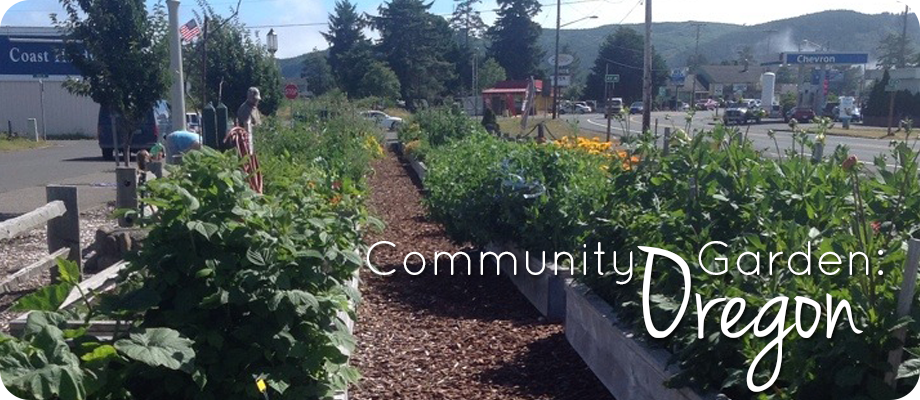
I’m not sure if this should be a ‘Traveling Plantswoman” post or not. I was traveling with my sister and her friend and I don’t usually visit many gardens when I travel with other folks. We normally focus hiking, golfing, and hot tubbig so as not to bore my companions with ‘Garden Stuff’, however, it is never far from my thoughts. As we were driving to do one of the ‘sanctioned’ activities I just couldn’t help myself this time. I hollered “Sorry…. I have to”. There on the side of the road was an abundance of raised beds and lush plants. It was between the busy 101 hwy and another road and there was a rail car at one end and beautiful gardens. We pulled into a parking space and spotted a family harvesting and planting so, of course, I had to talk to them and see what this garden was all about.
Frank and his wife Jennifer and their three kids were working in the garden. I was excited to see someone and to get a chance to ask them about the garden. They had just harvested a bag of onions and Jennifer had broken off the tops to give to the kids. These were little kids and they were eating them like celery or carrots and really enjoying them. They had a new crop of lettuce just planted and little baby radishes were almost ready to pick.
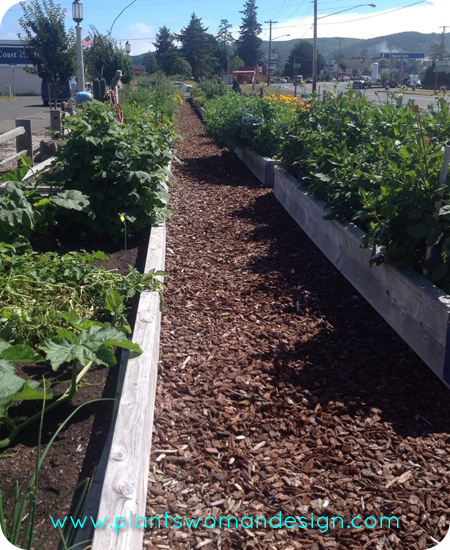 Fred took time to explain how they came to be there. They were a low income family who had used one of the scholarships to get a plot. They knew the two people on either side of their plot and they shared the produce. They were excited about teaching their children where food came from.
Fred took time to explain how they came to be there. They were a low income family who had used one of the scholarships to get a plot. They knew the two people on either side of their plot and they shared the produce. They were excited about teaching their children where food came from.
The family had not had a garden before but said they had help from other people in the community garden. They could email if they had a question and usually got a quick response. It was surprising how easy it was to grow vegs. They had a few problems that were unexpected. One problem they face is deer. How those beasties found this garden between two busy roads is amazing. But I guess if you plant it they will come. The other problem is thieves. I was surprised!
Community gardens can be anywhere and this garden clearly exemplifies that. We’ve had a couple of community garden posts (Albany Park, Albany Park #2 and Peterson) and we are glad to add this one to our list. It is exciting that more and more parents and communities want to help connect kids with “where food came from”.
Have you found a local community garden? Send us pictures!!! We want to see it.
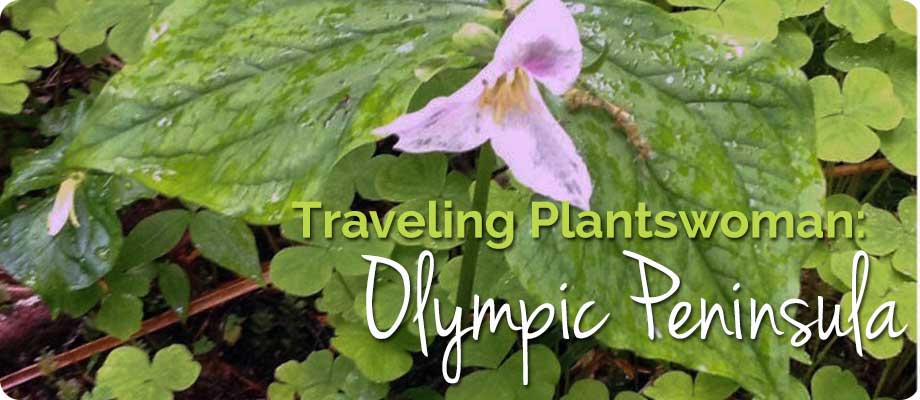
This weekend I ‘ran away from home’ again to the Soleduc River in the Olympic National forest. It was an unbelievably beautiful weekend with a mix of sun and showers. Though it was not warm, Spring was still in evidence and showing all the fresh green that we so look for after winter. This is the time that the leaves are coming out and they are so light green they seem to glow in the forest. Later in the year the same trees are various colors of green but never as vibrant as they are right now. By the time summer winds around they are tired and saturated colors of green change to bright yellows and oranges throughout the fall. In the Pacific Northwest we have a lot of evergreens but we also have a million shades of green.
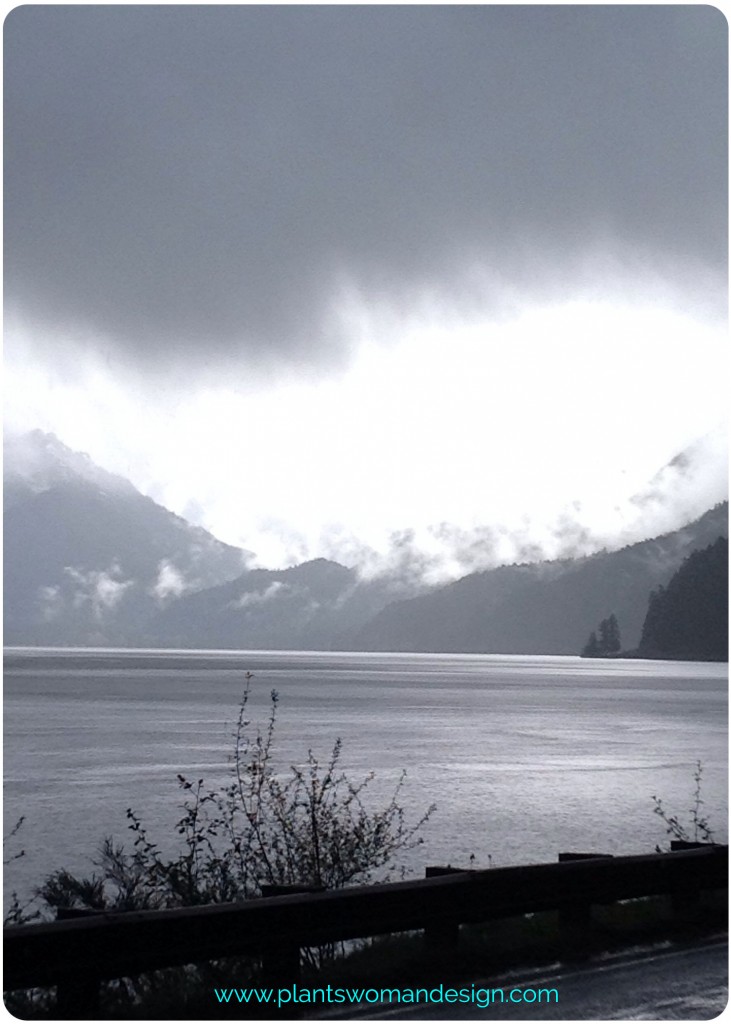
Can you spot the new snow on the peaks? It was 41 at the river this morning after a couple of days of 48 – 52 degrees. It doesn’t stop the relentless march of spring.
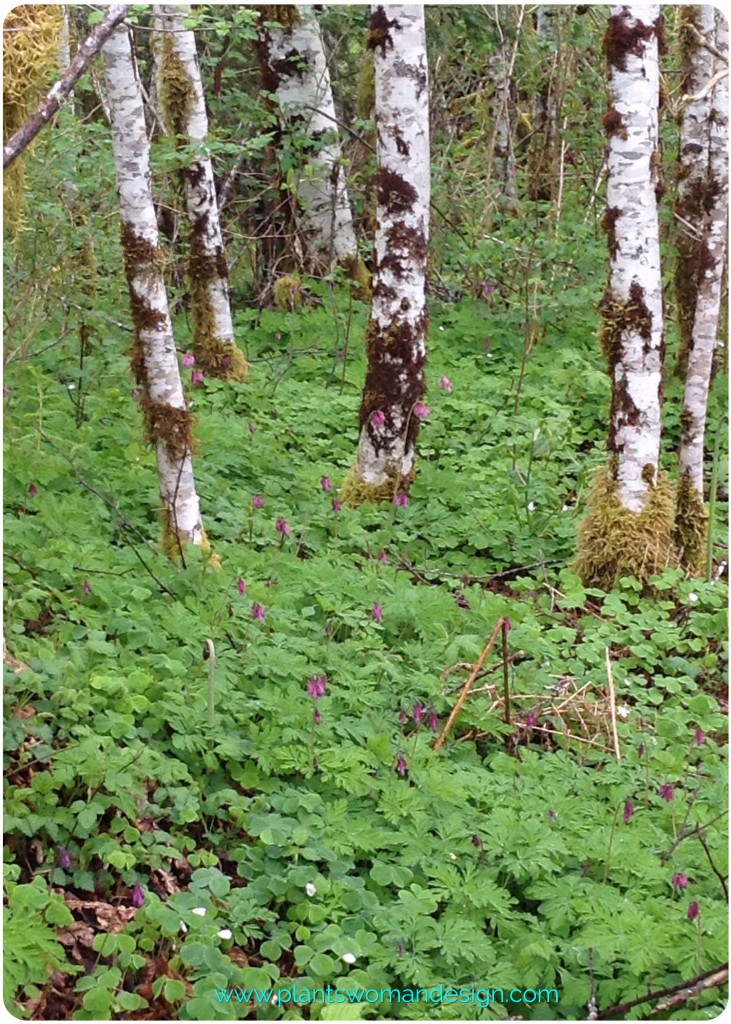
Trails through the woods have unrehearsed vignettes to view, proving that nature can be the best teacher.
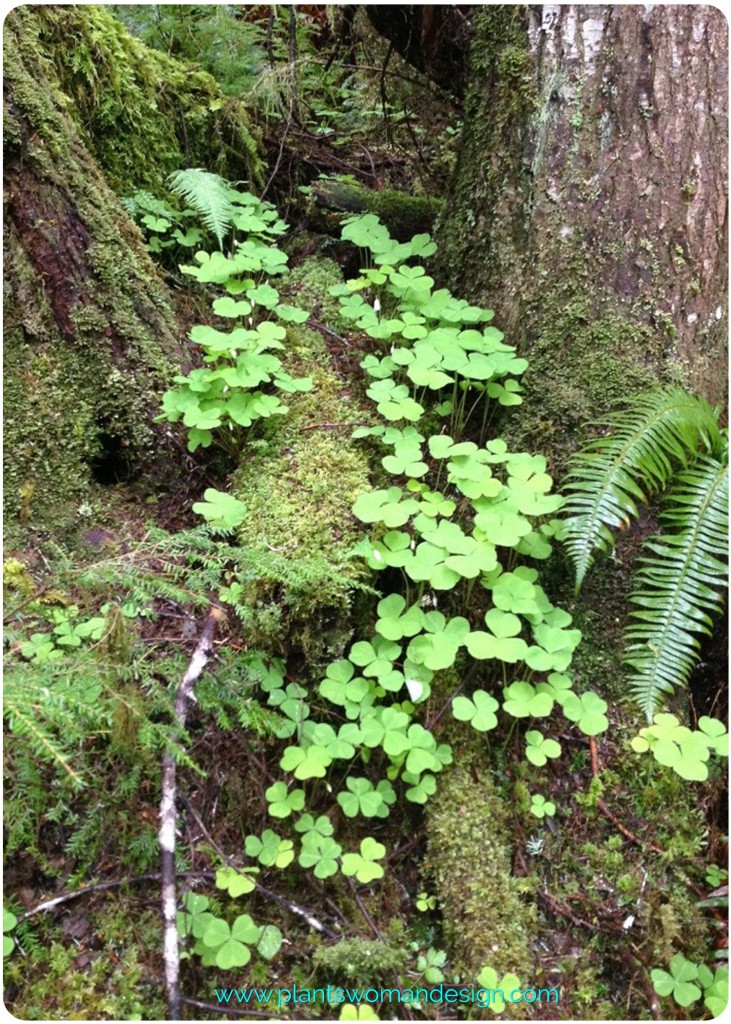
The contrast between hard and soft and dark and light is everywhere. The fresh green pops with the darker colors of decaying wood on the sides.
Few designers can make this happen ‘in captivity’.
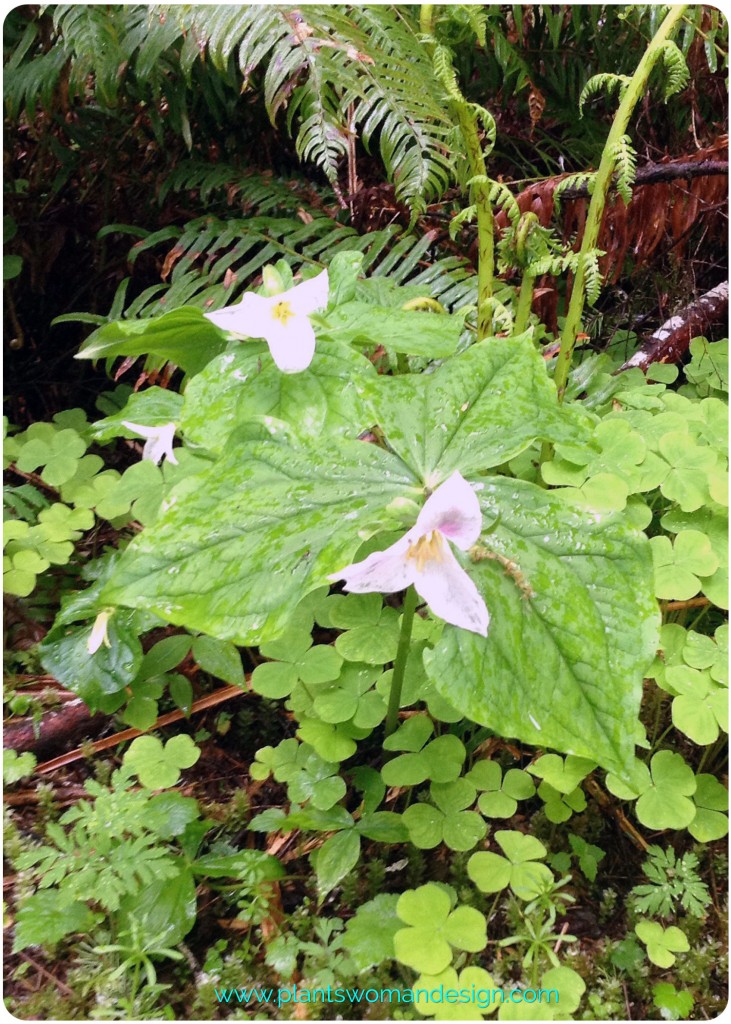
Native Trillium grandiflorum (Wake Robin), Oxalis oreganum (Wood Sorrel), tiarella cordifolia, (foam flower), and Dicentra formosa (bleeding heart)
Check out the recipes here at Wild and Slow (click on the link and then choose the wild edible you want to explore, e.g. wild sorrel). Sorry I sometimes get distracted by other posts from other lovers of things that grow wild.
Even Devils club (Oplopanax horridus) looks lovely and soft this time of year.
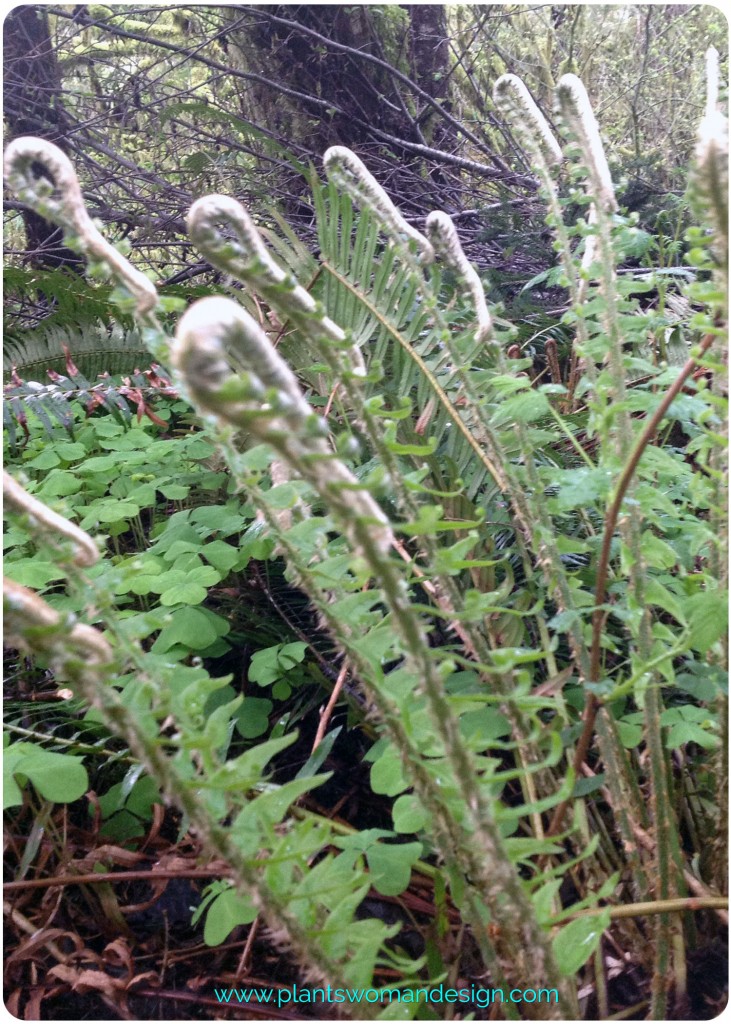 The Ferns are just unrolling and sending up sharp spires of green with soft fuzz on the stalks.
The Ferns are just unrolling and sending up sharp spires of green with soft fuzz on the stalks.

One of the most amazing things as I left the accounting world and started my own design business is that Spring happens one day at a time. I was amazed to see every day something new happening. Many of us (and me at that time) look up from the computer (desk, cash register, book, etc) and say ‘Wow, how beautiful! It’s Spring” . When really it happened just a little more yesterday, last week, and the week before that. If you find yourself being surprised by Spring’s sudden appearance I encourage you look a little closer, a little sooner, and a little more often. The beauty that surrounds us gives us the spark that makes each day worth living and it’s just waiting for us to see it.
Today’s challenge… Get outside today and take a snapshot of the beautiful nature around you. Send it to us at info(at)plantswomandesign(dot)com, we would love to see it!
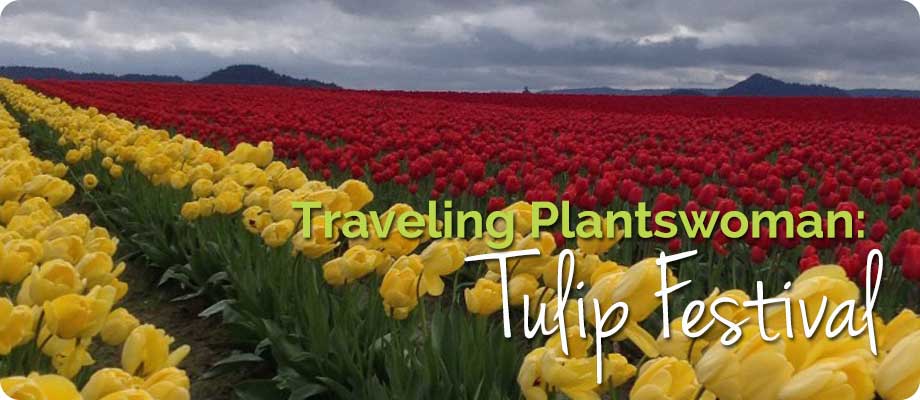
Sometimes people ask me ‘where do you get inspiration?’ I would have to say I go back and reconnect with the reasons I became a Landscape Designer in the first place. The wonder of spring, the fall colors, the cold winter with blooms still in evidence, the contrast between warm, cool and everything that happens in the middle. All of these things inspire me.
This past weekend I went to La Conner Wa to view the tulip fields. I have not been for a long time and they were FULL of people of many nationalities wandering through the fields enjoying the cool weather and the color. Oh, the color! It still amazes me that the growers don’t just throw the bulbs in any old way but intentionally plant the fields for color and contrast. For those of us who know nothing about the system, the color we see now is short lived. After they have bloomed they get the tops cut off and stay in the ground with leaves generating energy for big plump bulbs. I made the mistake of going the week after the festival one year to beat the crowds just to find no color.
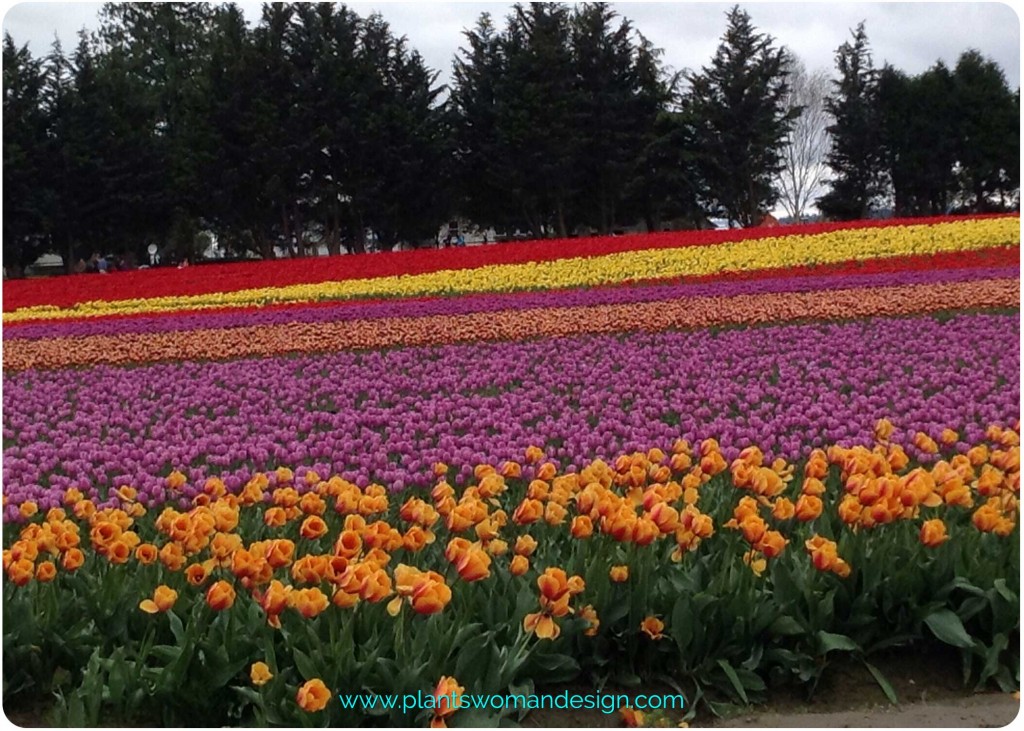
The Roozengaarde display gardens are truly beautiful. Full up with new varieties being tested it’s a good place to see new colors, shapes, and combinations.
You can check out all the varieties of these gorgeous bulbs on line at www.tulips.com. Order now and they are delivered next fall. Believe me the varieties do sell out. I have ordered bulbs online from other companies and they have not been successful. At the Northwest Flower and Garden show this year one of the other gardens had bulbs from Roozengaarde and they were amazing.
While photographing window boxes I also came across some great small courtyard gardens, Boston has such great old buildings. There are shared spaces between the houses (squares) that have huge old trees and places to gather. Often grass and benches, sometimes with shrubs to provide privacy. These are all the garden that some of these houses have access to. Several of the bigger houses had courtyards in front of them and many were wonderful serene small garden spaces.
This garden has a lovely sitting area for the times when, even though there can’t be much sun with the tall buildings on either side, it is warm enough to sit outside. The days were hot while I was there and evenings were lovely and warm with no coat needed.
Most of these fabulous gardens were fenced off from the street with ornate black iron fences. This area of Boston, just beyond Boston Commons, is one of the oldest in the city. Originally an area where statesman and writers lived it is now home to a variety of families along with some long time wealthier residents.
The details in this garden are lovely in their simplicity. The use of repeated white and green in the flowers and leaves along with the specimen arisaema and other unusual plants give it a calm quiet respite. It has a sophistication in planting that is in keeping with the house while not being busy. I will have to say I saw so many lovely hostas without any holes in them I’m thinking they don’t have slugs or snails there.
There are a few splashes of pinky red that stand out. The tri-colored beech- fagus sylvatica ‘Argenteo Marginata’. with Athyrium niponicum pictum, Japanese painted fern was stunning in the soft rain soaked air. A soft fuzzy light was filtering through the clouds and rain to make the pictures soft and fuzzy also.
Even very small spaces can entice a gardener to dig in the dirt.
The streets are narrow in this area also with very little parking and permits required for residents. There was the feeling of hushed quiet just a few steps from the bustle of downtown. This is one of the famed cobblestone streets.
I spent a great deal of time walking in Boston. It is a great way to see the city, meet people, and get a sense of the surrounding gardens and neighborhoods you walk through. Do you think you could live in a large city like this? Would you have to have enough space to garden?